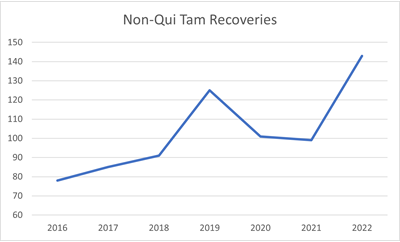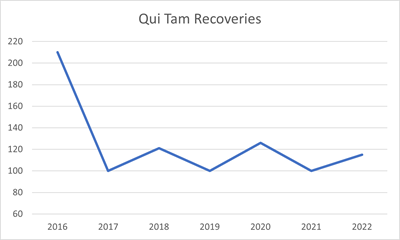FY 2022 FCA Year in Review
Fiscal Year 2022 is now behind us, and, by our count, the Department of Justice (DOJ) recovered $2.6 billion from False Claims Act actions over that period. This represents a significant drop from last year’s recovery of $4.4 billion, which was dominated by a single blockbuster recovery of $2.8 billion.
The devil, of course, is in the details. The DOJ has not yet announced statistics for FY 2022, but we at Qui Notes have been keeping track. Looking under the hood, we find a record number of non-qui tam recoveries, a slight uptick in the number of qui tam recoveries, and no slowdown in many recent trends—including the continuing trend of “blockbuster” cases (which we define as $100 million or more). We’ll post an update once we have the DOJ’s official announcement. For now, though, let’s dive in.
Non-Qui Tam Recoveries
On February 17, 2021, then-Acting Assistant Attorney General Brian M. Boynton announced that the DOJ would prioritize bringing more non-qui tam cases. He explained that anyone looking to understand the enforcement landscape needs to think “not simply about what types of cases are pursued, but also how those cases are identified.” He warned that the DOJ would be expanding its use of “sophisticated data analytics” to bring cases beyond those identified by private relators.
By the end of FY 2021, the number of non-qui tam False Claims Act recoveries had not materially increased. The number of non-qui tam recoveries in Fiscal Years 2020 and 2021 remained stable at around 100 per year, and AAG Boynton’s vision seemed unfulfilled.
Now, as we review Fiscal Year 2022, we see a different picture emerging. The number of non-qui tam recoveries spiked this year by a whopping 44 percent to a total of 143. This is the largest number of non-qui tam recoveries on record since we started tracking this information in FY 2016. The DOJ is making clear progress in its stated goal of augmenting the recoveries initiated by private relators:

Qui Tam Recoveries
Meanwhile, the DOJ has continued pursuing cases identified by private relators. As AAG General Boynton explained in his 2021 remarks, the DOJ’s expansion of its non-qui tam caseload would not come at the expense of other cases, as “qui tams will continue to be an essential source of new leads, and the Department will continue to rely on whistleblowers[.]”
The number of qui tam recoveries in FY 2022 was on par with recent years at 115, a slight increase year-over-year but less than the 126 qui tam recoveries in FY 2020:

Healthcare Industry Still in Focus
Continuing the trend from recent years, healthcare cases dominated the DOJ’s False Claims Act docket in FY 2022. Based on our industry breakdown, the DOJ recovered $2.4 billion from the healthcare industry alone—over 90 percent of its total recovery for the year.
Topping the list as this year's largest recovery was a qui tam case in the District of Massachusetts, announced in September, which brought in $900 million from a pharmaceutical company. The relator, a former employee of the company, pursued the case on his own for more than seven years after the DOJ declined to intervene. He alleged the company unlawfully induced prescriptions by paying kickbacks to physicians in the forms of speaker honoraria, speaker training fees, consulting fees, and meals.
Two other recoveries from the healthcare industry topped the list at more than $200 million each. These cases also involved allegations that the defendant pharmaceutical companies unlawfully induced prescriptions by paying kickbacks, among other allegations. Both were brought in the Eastern District of Pennsylvania.
Recoveries from the pharmaceutical industry represented 62.2 percent of the overall total recovery figure, and healthcare provider-related actions represented 23.3 percent. The healthcare industry was also the DOJ’s primary focus in terms of the total number of actions brought, representing 181 of the 258 actions resolved this fiscal year. As is typical, actions against healthcare providers made up the majority of these actions (140 total).
Other Trends
This year the DOJ made five “blockbuster” recoveries of $100 million or more, continuing the trend of these mega cases. All of the blockbuster recoveries in FY 2022 involved healthcare companies; four involved pharmaceutical companies as defendants and the fifth involved providers.
Outside the healthcare industry, the DOJ also made notable recoveries in cases involving federal programs with specific eligibility requirements. The largest non-healthcare recovery in FY 2022 was a $48.5 million settlement to resolve allegations by a qui tam relator that a company improperly obtained contracts that were set aside for service-disabled veteran-owned small businesses. In another qui tam case, brought in the Middle District of Florida, the DOJ recovered $13.4 million from a telecommunications company that signed up more than 175,000 ineligible customers for a federal program designed to subsidize cell phone purchases and monthly cell phone service payments for low-income customers.
Meanwhile, settlements again composed the vast majority of matters and dollars recovered, with trial judgments representing just a small sliver of both the total number of actions and dollars recovered.
Fiscal Year 2023 Outlook
Looking ahead to FY 2023, we expect to see the number of non-qui tam recoveries continuing to grow as the DOJ resolves more of the cases it identifies through expanded data analytics. While healthcare cases will almost certainly continue to dominate the docket, we also expect cybersecurity and cryptocurrency cases to make headlines in the near future, as Deputy Attorney General Lisa Monaco announced late last year that the DOJ would be prioritizing enforcement in these areas. When the DOJ announces a new initiative, there are often long delays before we see the first recoveries, particularly for cases brought by qui tam relators. We at Qui Notes will continue to monitor and report on these trends.
© Arnold & Porter Kaye Scholer LLP 2023 All Rights Reserved. This blog post is intended to be a general summary of the law and does not constitute legal advice. You should consult with counsel to determine applicable legal requirements in a specific fact situation.

